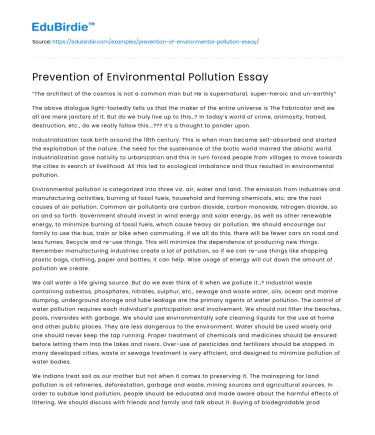“The architect of the cosmos is not a common man but He is supernatural, super-heroic and un-earthly”
The above dialogue light-footedly tells us that the maker of the entire universe is The Fabricator and we all are mere janitors of it. But do we truly live up to this…? In today’s world of crime, animosity, hatred, destruction, etc., do we really follow this….??? It’s a thought to ponder upon.
Save your time!
We can take care of your essay
- Proper editing and formatting
- Free revision, title page, and bibliography
- Flexible prices and money-back guarantee
Industrialization took birth around the 18th century. This is when man became self-absorbed and started the exploitation of the nature. The need for the sustenance of the biotic world marred the abiotic world. Industrialization gave nativity to urbanization and this in turn forced people from villages to move towards the cities in search of livelihood. All this led to ecological imbalance and thus resulted in environmental pollution.
Environmental pollution is categorized into three viz. air, water and land. The emission from industries and manufacturing activities, burning of fossil fuels, household and farming chemicals, etc. are the root causes of air pollution. Common air pollutants are carbon dioxide, carbon monoxide, nitrogen dioxide, so on and so forth. Government should invest in wind energy and solar energy, as well as other renewable energy, to minimize burning of fossil fuels, which cause heavy air pollution. We should encourage our family to use the bus, train or bike when commuting. If we all do this, there will be fewer cars on road and less fumes. Recycle and re-use things. This will minimize the dependence of producing new things. Remember manufacturing industries create a lot of pollution, so if we can re-use things like shopping plastic bags, clothing, paper and bottles, it can help. Wise usage of energy will cut down the amount of pollution we create.
We call water a life giving source. But do we ever think of it when we pollute it…? Industrial waste containing asbestos, phosphates, nitrates, sulphur, etc., sewage and waste water, oils, ocean and marine dumping, underground storage and tube leakage are the primary agents of water pollution. The control of water pollution requires each individual’s participation and involvement. We should not litter the beaches, pools, riversides with garbage. We should use environmentally safe cleaning liquids for the use at home and other public places. They are less dangerous to the environment. Water should be used wisely and one should never keep the tap running. Proper treatment of chemicals and medicines should be ensured before letting them into the lakes and rivers. Over-use of pesticides and fertilizers should be stopped. In many developed cities, waste or sewage treatment is very efficient, and designed to minimize pollution of water bodies.
We Indians treat soil as our mother but not when it comes to preserving it. The mainspring for land pollution is oil refineries, deforestation, garbage and waste, mining sources and agricultural sources. In order to subdue land pollution, people should be educated and made aware about the harmful effects of littering. We should discuss with friends and family and talk about it. Buying of biodegradable products is quintessential. We should switch to organic foods that are grown without pesticides. Personal litter should be disposed properly. We can separate household waste at home for recycling. The best way to curb land pollution is following simple three R’s, they are Reduce waste, Re-use things and Recycle things.
Under the pollution control approach, attempts to protect the environment have especially relied on isolating contaminants from the environment and using end-of-pipe filters and scrubbers. These solutions have tended to focus on media-specific environmental quality objectives or emission limits, and have been primarily directed at point source discharges into specific environmental media (air, water, soil). As environmental pollution control technologies have become more sophisticated and more expensive, there has been a growing interest in ways to incorporate prevention in the design of industrial processes – with the objective of eliminating harmful environmental effects while promoting the competitiveness of industries. Among the benefits of pollution prevention approaches, clean technologies and toxic use reduction is the potential for eliminating worker exposure to health risks.
Earth will regain its beauty, but only if we human perform our duty. “Treat the earth well. It was not given to you by your parents. It was loaned to you by your children”. This Kenyan proverb marks the pungent need of the hour i.e. eco-friendly lifestyle. It is high time that we stop the blame game and take initiative and responsibility to conserve and preserve our nature. We all want to extend our generation, then why not gift them an environment that is safe, healthy and free of pollution. Let our future generation see the exploding palms, clear skies, elegant waves, etc. In short let them enjoy the mesmerizing beauty, the elegance of nature and live in a safe, healthy and uncontaminated environment.






 Stuck on your essay?
Stuck on your essay?

